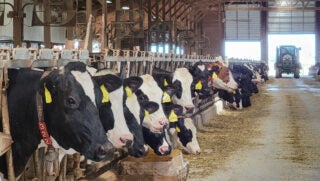If you love winter, there’s a good chance you’re not raising livestock in frigid temperatures. The past two weeks will go down in history with record-breaking cold and blizzards across the United States. In Deadwood, South Dakota, reports of 12 to 40 inches and up to 50 inches in some areas were recorded. Semis were stranded, farmers stepped up to help neighbors, and one farmer even spent 27 hours stranded in his tractor. But, amidst the gelling fuel and drifting snow, the farming and ranching industry has come a long way in the battle against winter storms, and has continued proving they’re always willing to lend a hand, semi, tractor, or whatever it takes to take care of each other and their livestock.
Ranches are prepared for winter, but that doesn’t mean it’s easy
Between 1880 and 1885, open range ranchers were running as many as 80,000 head per operation. An extreme drought, hot summer, and limited resources left herds in poor condition and in no shape to fight the frigid temperatures and blizzards of the 1886 winter. Known officially as the great extinction, nearly 25 percent of cattle grazing on open ranges in the West died during this storm. this period is also known as the “Big Die Up, “Great Die Up”, and “Death’s Cattle Round-Up.”
So, ranchers adapted. Cattle herds were downsized, fences were erected to better manage lands, and keep cattle closer to food sources. Operations began raising feed and supplementing cattle diets during the cold, winter months.
Feeding is great, except when equipment doesn’t run
Across the U.S., reports of farmers and ranchers clearing roadways for people and pulling people out of the snow can be found on social media. The cold weather makes diesel gelling and hydraulic equipment difficult to run, but caring for livestock and the people who live near you is an integral piece of winter rural living — even if it means getting stuck.
One 70-year old rancher Rodney Paulson of Todd County, South Dakota became stranded when he went out to feed his cattle on Thursday according to local news. After his neighbors tried to free him, he again became stranded farther down the road and it was decided that he was going to have to spend the night in his tractor. Thankfully, he had enough fuel and heat to keep the tractor running until a trucker headed down Highway 18 came across vehicles stranded. The trucker had a tracked tractor loaded and headed to a dealership in California that gave him the green light to help.
“I bet I called the dealership about three or four times total because I just wanted to make sure it was OK for what we were doing with that thing. And they said, ‘Yeah.’ No hesitation,” Spartz told the local news station.
Crops may be affected by cold weather
Cold weather snaps are putting pressure on recently planted crops. Commodity prices for winter wheat have risen for the fourth day in a row as cold temperatures hit the grain belt.
“From a climatic point of view, the drop of temperatures in the US over the weekend will be closely watched with the risk of frost damage to winter crops,” according to Agritel analysts.


